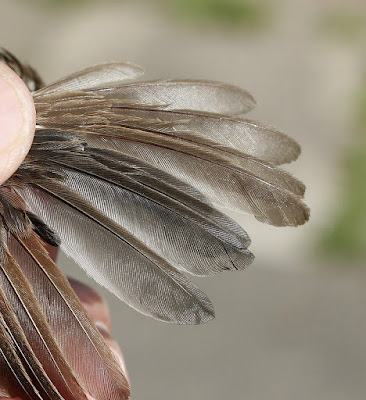At last! After a week of dire weather there was a 5mph wind; although there was a gloomy, misty start, the murky skies cleared within the hour.
I met up with Andy at Oakenclough where we expected to catch up with the species, if not necessarily the individuals, we missed in the interim. At this time of year many birds are on the move in either post-breeding dispersal or actual southerly migration. If the weather is not too good birds will fly around or above the obstacle or even delay their flights until conditions improve. Such things make for exciting mornings when we may have an idea of what species to expect in but not necessarily the numbers.
Gloomy Start
The early overcast may have blocked some early movement but we finished up with 24 birds of 8 species as follows: 5 Willow Warbler, 4 Chaffinch, 4 Great Tit, 3 Tree Pipit, 2 Goldcrest, 2 Goldfinch, 1 Dunnock, 1 Robin.
We caught the five Willow Warblers early one while it was still misty but none later, suggesting that they were leftovers from Monday or before. All five proved to be birds of the year. The numbers of young Willow Warblers seem to be up this year and we speculated that the excellent summer with the lack of the usual downpours has helped ground nesting species like Willow Warblers.
Willow Warbler
TREPI is the computer input code for Tree Pipit. Inputting this morning’s data is a job for later in the day via the BTO’s DemOn, (Demography Online) an on-line application which allows users to input their ringing and/or nest records. All three Tree Pipits were birds of the year – juveniles.
DemOn
As Tree Pipit breeds sparingly in the North West of England we can be fairly sure that the three caught this morning are from the Scottish population, or maybe even from Scandinavia. Maps that show the Tree Pipit breeding right across the UK are in fact inaccurate as the species' range is more limited.
Tree Pipit distribution - RSPB
Tree Pipit
Tree Pipit
Goldcrests are bang on time and we should now catch good numbers right through to November.
Goldcrest
Dunnock
The young Robin showed just a hint of red breast.
Robin
There seemed to be Chaffinch on the move this morning when a few small parties flew over giving their characteristic, soft, “chip, chip” contact call.
Chaffinch
Other birds seen during the four hour slot - 1 Great Crested Grebe, 1 Buzzard, 1 Pied Wagtail, 1 Redshank, 2 Cormorant, 8 Goldfinch, 20+ Chaffinch. After the mist cleared and the air warmed a number of Swallows appeared, mostly heading south in singles or small parties of between 2 and 6 individuals - in all 30+.
Linking today to Stewart's World Bird Wednesday































































.jpg)












